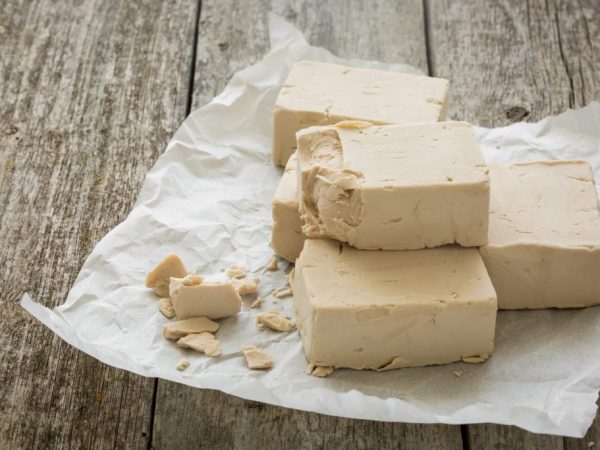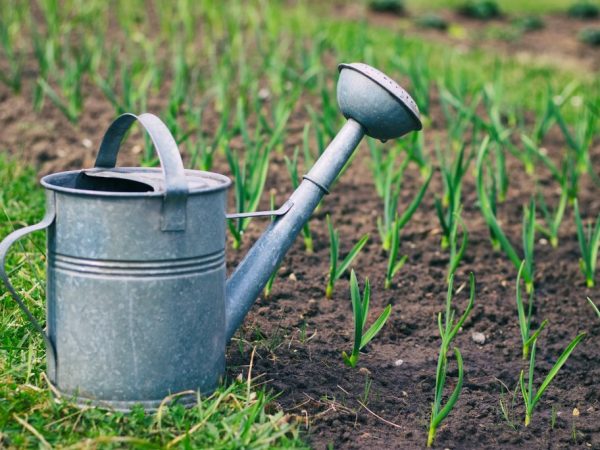How to properly feed garlic with yeast
Yeast is one of the most popular fertilizers for feeding vegetables. They are rich in protein, minerals and iron in an organic, easily digestible form. Feeding garlic with yeast ensures rapid growth of the root system and makes it possible to actively develop greenery, even in dimly lit places.

Feeding garlic with yeast
The benefits of feeding
Feeding plants with yeast is mainly practiced in spring and summer. The earth at this time is already warmed up enough, which means that the substance contained in this fertilizer will react faster with the soil. It is used both for seedlings in greenhouses and for plants planted in open ground.
The effectiveness of this method of plant feeding:
- active growth of culture in greenery;
- strengthening of leaves and stems;
- improving the development of the root system
- increased productivity;
- increasing resistance to diseases and pests;
- environmentally friendly fruit, since all components are natural;
- savings, since the cost of the main product is not high.
Care must be taken when calculating dosages and amounts of dressings. An overdose will have a negative effect on the plant and its fruits.
In the process of fermentation of such fertilizer, a lot of calcium and potassium is washed out in the soil. And these substances are no less useful than minerals and living components. Ash helps to cope with this disadvantage. Some time after feeding, it is recommended to water the plants with clean water, and then spray the prepared ash from wood, leaves and other plant components on top. Ash can be scattered between the rows.
Such fertilizer should be applied only at the root. When applied to foliage, top dressing can severely harm the plant and reduce productivity.
How to prepare top dressing
There are several recipes for feeding with yeast. The most common ones are:
- For 10 liters. water take 10-11 g of dry yeast, 5 tbsp. tablespoons of granulated sugar, 0.5 liters of aged chicken droppings and 0.5 liters of wood ash. Mix everything and use after 2-3 hours, diluted with water 1:10. It is strictly forbidden to feed in its pure form.
- For 3 liters of warm water, take 100 g of live feeding (yeast) and 0.5 cups of sugar. Mix everything and leave to ferment in a warm place for 2-3 hours, after covering the container with gauze. Stirring occasionally. Finished dressing comes at the rate of 1 glass to 1 bucket of water.
- For 1 pack of dry yeast, take 1 tbsp. sour milk and 1 tbsp. ash, place in a container with a volume of 10 liters. Wrap with a towel and leave in a warm place to ferment, stirring the mixture 2 times a day. After a week, the fertilizer will be ready.
- For 10 liters. take 100 g of warm water. dry yeast, add crackers and crusts of rye bread, a little sugar. Insist for at least 4 days. Dilute the finished mixture 1:10 before use.
- In a small container, put chopped nettles and weeds, herbs, pour warm water and put in the sun for fermentation. The mixture must be stirred periodically. After 7 days, add 0.5 kg of raw yeast to the composition. Start feeding after 3 days.A bucket of water will take 1 liter. sourdough.
These simple methods can significantly improve productivity and yield. You just need to remember that excessive consumption of this product can make the soil hard and infertile.
How and when to feed

Yeast fertilizer will strengthen plant roots
In early spring, when the first shoots of greenery appear, it is recommended to fertilize and feed the plant. To make the feathers of onions and garlic lush and green, warm yeast fertilizer will help. Thanks to him, the roots will become stronger, and the vegetative part is thicker.
First feeding
The first feeding of onions and garlic should be in the spring, regardless of planting time, after the appearance of the first feathers. It is better to feed the first time in the first decade of May, since the greens will already sprout, and the soil will be warm enough for fermentation. The recommended temperature on the site is not less than 20 ° С.
The ground must first be loosened and watered. Then you need to take a glass of the finished starter culture and dilute it in 10 liters of water. Water the plants under the root with this solution. Greens, after fertilization, should actively grow.
Second feeding
The second top dressing occurs at the beginning of summer, or rather, in the last days of June or in the first decade of July, when the vegetative part of the plant has already begun to develop rapidly. It is recommended to fertilize in the same way, at the root, trying not to hurt the foliage. If the solution gets on the stem and leaves, you can spray the bushes 3-4 hours after fertilization. This will cleanse the stems and leaves (feathers) of the plant from accidental ingestion of the live mixture and protect the garlic from a possible negative reaction.
Third feeding
The third feeding is desirable at the time of onion or garlic head development. Due to the strong root system, the head of garlic is actively gaining volume. It is during this period of time that the root system of the plant draws a lot of juice from the ground, and if the soil is depleted or simply does not have a sufficient amount of the necessary vitamin compounds, the plant is threatened with growth retardation and disease.
Do not feed the plant with yeast more than 3 times per season. This can be easily damaged and counterproductive.
Conclusion
Yeast dressing is known and popular for its active properties, which strongly affect the plant and yield. But it was often noticed that due to its use, the heads of onions, garlic, as well as potatoes become large and loose from the inside.
Such a vegetable or root crop is not intended for long-term storage and harvesting for the winter. Therefore, before feeding such a plant, think carefully about whether it is worth it. After all, what is useful for growing greens does not always suit the root fruit.


